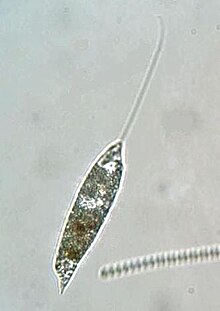| Peranema | |
|---|---|

| |
| Peranema sp. | |
| Scientific classification | |
| Domain: | Eukaryota |
| Phylum: | Euglenozoa |
| Class: | Euglenida |
| Order: | Peranemida |
| Family: | Peranemidae |
| Genus: | Peranema Dujardin, 1841 |
| Species | |
|
See text | |
Peranema is a genus of free-living phagotrophic euglenids (Euglenida; Euglenozoa; Excavata). There are more than 20 nominal species, varying in size between 8 and 200 micrometers.[1] Peranema cells are gliding flagellates found in freshwater lakes, ponds and ditches, and are often abundant at the bottom of stagnant pools rich in decaying organic material.[2] Although they belong to the class Euglenoidea, and are morphologically similar to the green Euglena, Peranema have no chloroplasts, and do not conduct autotrophy. Instead, they capture live prey, such as yeast, bacteria and other flagellates, consuming them with the help of a rigid feeding apparatus called a "rod-organ." Unlike the green euglenids, they lack both an eyespot (stigma), and the paraflagellar body (photoreceptor) that is normally coupled with that organelle.[3] However, while Peranema lack a localized photoreceptor, they do possess the light-sensitive protein rhodopsin, and respond to changes in light with a characteristic "curling behaviour."[4]

The earliest record of a Peranema is in O.F. Müller's Animalcula Infusoria of 1786, which describes an "elongated linear" creature, "stretched out at the front." Müller named it Vibrio strictus, placing it among the "long-necked" infusoria, along with Lacrymaria olor and Dileptus.[5] The species Peranema trichophorum was seen and described in 1838 by C.G. Ehrenberg, who, like Müller before him, took the flagellum for a necklike extension of the body, and placed it in the ciliate genus Trachelius.[6] Peranema was correctly identified as a flagellate by Félix Dujardin, who created the genus in 1842, giving it the name Pyronema, for its pyriform (pear-shaped) body. However, because that name had already been applied to a genus of fungi, he amended the genus to Peranema, formed from the Greek πέρα (a leather purse or sack) and νήμα (a thread).[7] Unfortunately, this name had also been claimed earlier, for a genus of ferns first collected in Nepal. As a result, botanists, following the International Code of Botanical Nomenclature, customarily refer to the protist Peranema as Pseudoperanema; whereas protozoologists, following the International Code of Zoological Nomenclature, have continued to call the genus by the name Dujardin gave it.[8]
- ^ "Encyclopedia of Life".
- ^ Mast, SO (Mar–Apr 1912). "The reactions of the flagellate Peranema". Journal of Animal Behavior. 2 (2): 91–97. doi:10.1037/h0072097.
- ^ Brown, Virginius E. (1930). "The Cytology and Binary Fission of Peranema". Quarterly Journal of Microscopical Science. 2 (73): 6.
- ^ Saranak, Jureepan; Foster, Kenneth W. (2005). "Photoreceptor for Curling Behavior in Peranema trichophorum and Evolution of Eukaryotic Rhodopsins". Eukaryotic Cell. 4 (10): 1605–1612. doi:10.1128/EC.4.10.1605-1612.2005. PMC 1265905. PMID 16215167.
- ^ Müller, OF (1786). Animalcula Infusoria: Fluvia, Tilia et Marina. Hauniae, Typis N. Mölleri. pp. 71.
- ^ Saville-Kent, William (1882). A Manual of the Infusoria. Vol I. London: David Bogue.
- ^ Dujardin, Felix (1841). Histoire Naturelle des Zoophytes. Infusoires. Vol. I. Paris: Roret.
- ^ Patterson, David J.; Larsen, Jacob (January 1992). "A Perspective on Protistan Nomenclature". Journal of Eukaryotic Microbiology. 39 (1): 126. doi:10.1111/j.1550-7408.1992.tb01292.x.